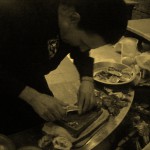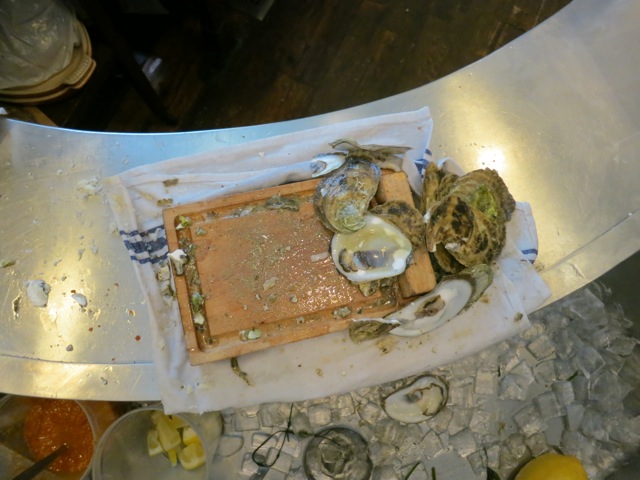Shucking Competition Rulebook
Penalties:
CUT OR DAMAGED OYSTER MEAT
Oyster shucking competitions, like cocaine and the ROM, will make lofty claims and promises but too often deliver a dead hand, all approach, sum more zero than other amusements.
For spectators it is magic without midpoint, a casually murderous roundelay broken by awkward intervals of sweep, clear and reentry. Of course the trick is never revealed and the payoff comes long after knives roll free. Alcohol floods the event like a balm over the double threat of experience and discovery, while a miscast of contestant retinues, industry grandees, photogs & videogs, food bloggers, knifey wifeys, claque-cliques and harried event staff come together like the sewn face of an embalmed cadaver without the dignity.
For contestants looking out over the abyssal gulf between observer and participant in sporting events, it can take on many forms: psychological drug deal gone sour, mind-body tightrope walk with holographic safety nets, or even just a messy vignette between beer-cup handoff and retrieval. On a temporary stage where celebrants become assailants for a day, defenders and former champions lie in wait for the later heats, veterans with frayed nerves ‘n’ tendons try again to shoot the moon, and beginners get to get it over with in the name of their restaurant or caterer. Some of the veterans will include decade-plus contestants searching still for their first win. In the music industry, such embloodied blade gunners are wagged as “contest whores”, but they can be the most interesting shuckers to watch and hit up for storied counsel, and they tend to enliven competitions with their coot hauteur and tenacity. (I have theorized that competitive shucking is most like snooker, in which the first heightened sense to fail is the sharp eyesight required to discern planes and angles. This could help to explain the infrequency of better-with-age cases in competition. Or maybe not).
So viewed up close, competitions can be brilliant fun with the fun of little brilliancies. The unnatural shucking act is perhaps best honoured in the breach, so all the better to stage a more purgative than dramaturgative production. Alcohol is essential to this purpose: we’re killing here, so why not get florid on a killing floor? It’s a dance of damage, calcium flying helter skelter in promotion of anything but healthy bone growth.
SHELL OR GRIT IN OYSTER
Embracing the “not” over the “oh so very IS”, oyster competition judging seeks not forward motion but a turning away from the curious starting point of the “perfect plate” (which was once actually claimed at a national competition in the 1990s, a somewhat twin-snowflaky declaration contra photo evidence) to ride a tide of nots by giving the gift of extra time: each assessed penalty results in additional seconds added to the contestant’s original, or “flat” time. Beauty in its moveable forms – technique, plating, stylistic distinction – is dashed, unmeasured but for the adjunct award of “Cleanest Plate”. This is the plate with fewest assessed penalties, which commonly (but not always) indicates a slower flat time far behind the leaders. It seems a token gesture to placate those wishing for more creative acknowledgment this side of the isthmus, and it probably is; yet its importance to the exercise cannot be overstated if we are to take at face value the idea behind judging criteria. Aren’t we supposed to imagine a busy restaurant service with the volume turned up full? If this is the case, plating style should play more than a second division role.
Geoffrey Meikle, the cleanest shucker of the first generation of Toronto competitors (and for whom the Cleanest Plate award was named in several different competitions) never won a national title but was a formidable influence on both restaurant and competitive shuckers. A former national champion told me recently of his early inspiration watching Meikle “beautifully fanning out his oysters on the competition tray”. When a plate is satisfying in a geodesic way it can only heighten a guest’s ritual excitement; the feat is all the more exciting for occurring during a crazy juicy oft-bloody wild service or, say, during a shucking competition. And in over a decade of competitions I have managed to produce, pace penalties, an interesting-looking or even beautiful plate perhaps once, more likely one less. Largely unexampled outside of Meikle and his acolytes, this show of supercool bomb-squad equanimity ought to be rewarded somehow.
OYSTER NOT SEVERED FROM SHELL
Wait a moment, how exactly did we get here? Such pervasive perversive attachment to such a craft at such a time in such an epoch is a form of espousal abuse at best, and at least a studied deferral whose outcome is always more meretricious than merit-based. But for all this superstar fun, the final step can be the real work, being the blindest of blind motions. There is simply no time to stop and lift gingerly the entire piece before plating. The judges will take care of this for you, so better to be certain – but how?
In seminars I used to advise the keeping of a sharp eye on the movement of the oyster during the finishing step. “If the entire piece appears to move towards or away”, it is severed. This was inaccurate, as even the tiniest connective strand can remain to hike your adjusted time right out of contention. The rest is a matter of individual technique which is often explainable or transliterated only between shuckers — but, as in professional wrestling, the sight of a finishing move is one of the truly illuminating and fascinating details of competition.
OYSTER OUT OF SHELL
When a contestant climbs onstage, all bets are off: you are now one with the jettisoning of subtle hand-eye correspondences in a shotgun marriage of the sclerotic and spasmodic. In my first few competitions I would freeze over the shucked piece admiring or despairing of it before removing it to the ice tray, then reach out herkyjerk and grasp dead air, one too many, or the wrong one in the carefully prearranged queue. For Step One of five, an oyster can be entered almost anywhere but the distinct mantle opening is most efficient; yet to this day, in the sub-2 min juice of onstage performance, my knifetip can miss the target, sliding up or alongside the top shell, clanking the wood underneath or air-slashing close to the fleshy base of the opposing thumb. In these sudden directionless moments the mantle is a ridge of sighs as nanoseconds lost are anxiety gained.
The Oyster Out Of Shell penalty, perhaps the most embarrassing as denoted by its podium-killing cost of 25 seconds at some competitions, is a close tracker and reminder of the dangers of extrinsic mechanical breakdown which, occurring midstream, will ensure an upstream journey for the rest of your onstage visit. Here the fact that you have demonstrably severed the oyster from its shell will do you no good. When inflicted during plating, the aforementioned gun-jumping motion can cause the piece to fly from its shell which, if left unrepaired, will rank with a figure skater’s faceplant into the ice. But this most serious of penalties can be overlooked in a situation where the contestant moves with the imperturbable calm of someone trying to unlock a car door to escape a charging grizzly.
It must be noted here that such paresis and/or extraneous movement can be brought on or exacerbated by the influence of the stagefront charivari, without which the whole enterprise cannot really be called competitive: at provincial and national competitions the contestant must focus, shuck & plate 18 pieces in front of hundreds of screaming revelers goaded to scream louder and drink more heavily by a duly aggressive emcee tasked to keep the event greased and rolling. Not that the contestant is so different — even repeat champions are known to swim in their fave neural acid bath before taking the stage. Adjustments must proceed as read, since (as previously bemoaned) shucking mechanics are already elusive, implacable and unforgiving enough during any restaurant service. So the strongest component and greatest challenge of shucking competitions may be the necessity of managing one’s nerves under an unconventional stress.
As well, such unconventional stress must be restricted to vocational entrants. One more or less uniform rule across the country is that a contestant must represent a caterer or restaurant, no domestic kitchen shuckers. YES, anyone can walk in off the street, shuck their first oyster onstage and win a competition. But no one ever will.
BLOOD IN OYSTER
“It will never live again” was a seminar truism I wish I’d said, for it is teeming with objective bivalve truth. Whether or not severed at the Finish step, the oyster is neither alive nor dead but far closer to the latter. Death is everywhere but on the PA system, which forgoes the apposite fare of the Berlioz Requiem or Chopin B Flat Minor in favour of a differently visceral programming. At competitions I organized I would instruct the deejay to blast a more incantatory mix during heats, but today most rely alone on rhythms of emcee accompaniment.
The Blood In Oyster penalty is understandable given the circumstances but absolutely indefensible in a restaurant situation, hence its punishing cost. Keeping with the underlying slaughterhouse miniature, by the time the winners are announced the stage is thick with just as much mammal as shellfish DNA. Blood jumps and flows in a dancing homage to the brief life of the oyster, which is just fine until it colours your work. The catch here is that the contestant will not usually be aware of a cut suffered until he or she sees it in the one spot it must not be allowed to appear. But by then it is too late. Like the Cut or Damaged Oyster Meat penalty, it can clearly be seen after it can no longer be avoided or addressed, which contributes mightily to contestant anxiety.
At a recent competition, after I tapped out and walked offstage I became aware, with a sort of detached interest, that I had busted open my thumb on either knife or shell or both. I was lucky to keep it safely off the plate, but others aren’t so fortunate. I once watched an industry shucker/owner suffer a fleshy cut during his heat, after which he was unable to keep blood out of several oysters. He tapped out early for a DQ, then remained onstage to rub his bloody hand over his face several times to general audience revulsion. Perhaps Jubal Brown or Damien Hirst could have run with it, but somehow it wasn’t as funny as it could have been.
TOTAL ADJUSTED TIME
After inaugurating two separate shucking competitions in Calgary with markedly different mobile setups and product (but identical judging criteria), I invited a food critic to sit on the panel. The morning of the festival I looked at his column and no mention was made of the event. Later I asked if he’d forgotten and he shrugged. “It’s industry.” It was just as surprising as the persistence of the “oysters in ER months” canard. I have not knowingly met an oysterphobe who is not at least morbidly curious about the shucking act and quick to repeat prurient slogans. Guests with no intention of ordering product will still park in front of the oyster station to follow the action at the raw chef’s table. I have never attended a competition in which industry wonks & wanks outnumbered civilians.
So taken for all due depravity, oyster shucking competitions can be as marvelous and insightful as a Pistols show or reading Gibbon. It is delightful shellfish snuff porn for all, from spectators who can only follow the action with emcee guidance and timing of tap-outs, to competitors leaning in close with hundreds of ideas bouncing round their heads, hoping to still their heart rate enough to follow through on their strategies. For contestants and spectators there is drama, injury, heartbreak, joy and vodka. For contestants alone there is immanence, understanding and belonging. We are venerable degenerates rewarded for the efficiency and cleanliness of a killing motion, skirting the lines between mind-body breakthrough and malevolent impalement. What could be more agreeable?
 Anthony Wing can be found in the company of oysters at Zee Grill, 641 Mount Pleasant Road, and Union, 72 Ossington Avenue, Toronto, Ontario, Canada.
Anthony Wing can be found in the company of oysters at Zee Grill, 641 Mount Pleasant Road, and Union, 72 Ossington Avenue, Toronto, Ontario, Canada.









Another fine piece of writing! Far more refreshing and real then any food network special could ever go!
Every sentence a masterpiece. As always.